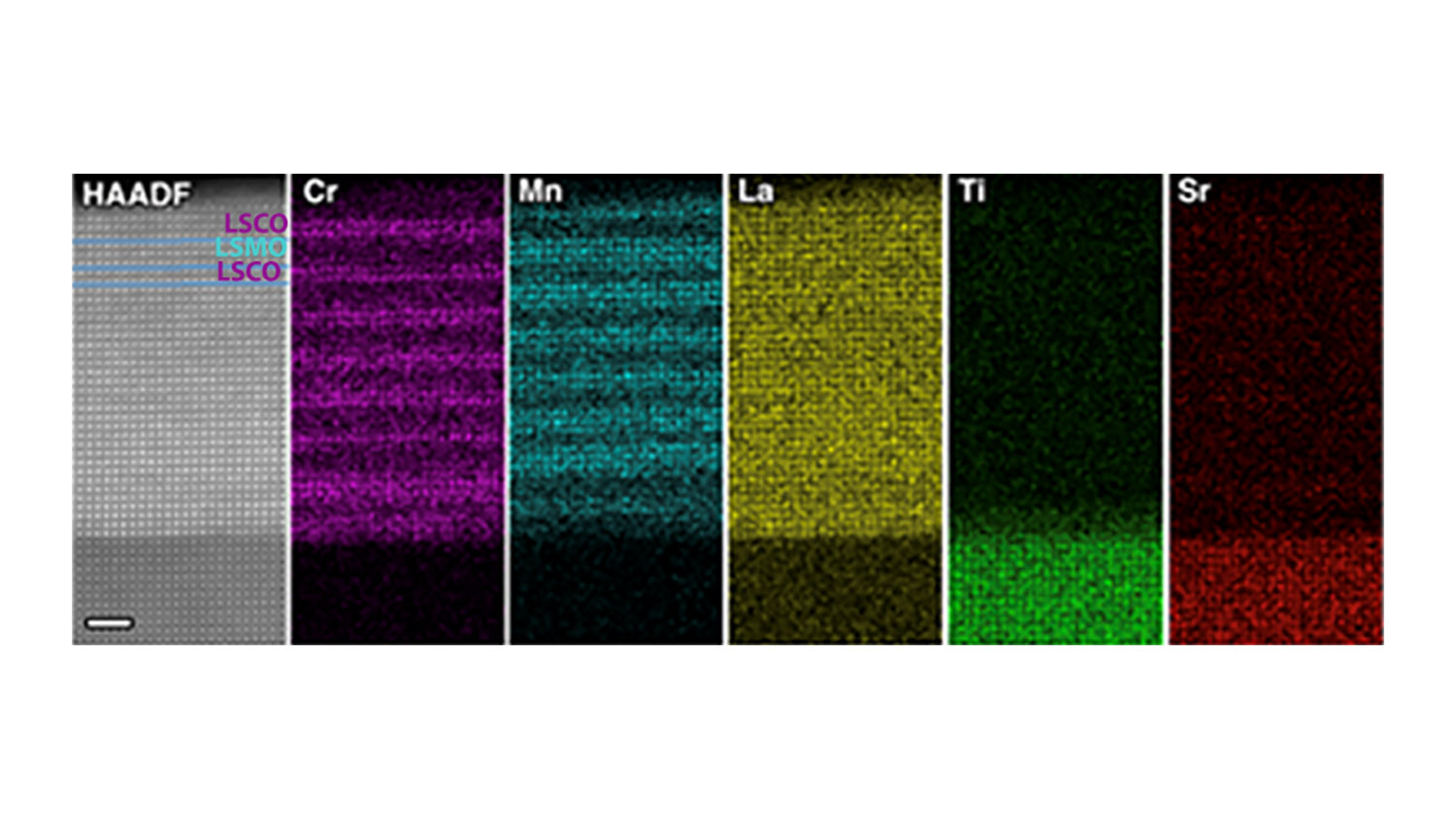‘Sandwich’ Structure Key to Thin LSMO Films Retaining Magnetic Properties

Researchers at North Carolina State University have found that the oxide ceramic material lanthanum strontium manganite (LSMO) retains its magnetic properties in atomically thin layers if it is “sandwiched” between two layers of a different ceramic oxide, lanthanum strontium chromium oxide (LSCO). The findings have implications for future use of LSMO in spintronic-based computing and storage devices.
In its bulk form LSMO has both magnetic and metallic properties. The conductivity of the material can be altered by changing its magnetic field, which makes LSMO appealing for use as a switch in spintronic devices. However, when the material gets to a certain thinness — between five and 10 atomic layers — it loses these properties.
Divine Kumah, assistant professor of physics at NC State and corresponding author of a paper describing the work, wanted to know why LSMO loses its magnetic properties at a particular thinness, and to find a way to make LSMO magnetic in thin form.
Kumah, with colleagues and graduate students from NC State, first grew thin films of LSMO on strontium titanate — a non-magnetic substrate commonly used as a neutral scaffold. The team grew films ranging from two to 10 atomic layers thick and tested them for magnetic properties.
Next, the team utilized the synchrotron light source at Argonne National Laboratory so that they could get a three-dimensional view of the arrangement of the atoms within the thin layers of LSMO. They found that at extreme thinness, the oxygen and manganese atoms moved slightly out of alignment on the surface of the material, effectively switching off its magnetism.
“At about five atomic layers we saw distortions on the surface of the layer and at the bottom interface with the scaffold,” Kumah says. “The oxygen and manganese atoms rearrange themselves. Magnetism and electrical conductivity in LSMO are related to how these two atoms bond, so if there are polar distortions in the film where they move up and down, the bonds stretch out, electrons can’t move through the material effectively and magnetism is switched off.”
The team noted that these distortions started at the top of the film and extended approximately three layers below surface.
“We found that the distortions occur because the crystal structure creates an electric field at the surface,” Kumah says. “The oxygen and manganese atoms move in order to cancel the electric field. Our challenge was to grow something at the interfaces that is compatible with LSMO structurally but that is also insulating — so that we remove the electric field, stop the movement of the oxygen and manganese atoms and retain magnetic properties.”
The researchers found that by using two layers of LSCO on either side of the LSMO, the LSMO could retain its magnetic properties at two atomic layers.
“It is like a sandwich — LSCO is the bread and LSMO is the meat,” Kumah says. “You can use fewer than five layers of LSMO in this arrangement without any atomic displacement. Hopefully our work has shown that these materials can be thin enough to be useful in spintronics devices.”
The research appears in npj Quantum Materials and is supported by the National Science Foundation and the Department of Energy. NC State Ph.D. student Sanaz Koohfar is first author. NC State graduate student Aubrey Penn, and James LeBeau, associate professor of materials science, along with Alexandru Georgescu of the Flatiron Institute and Elke Arenholz of Lawrence Berkeley National Laboratory also contributed to the work.
-peake-
Note to editors: An abstract follows.
“Confinement of magnetism in atomically thin La0.7Sr0.3CrO3/La0.7Sr0.3MnO3 heterostructures”
DOI: 10.1038/s41535-019-0164-1
Authors: Sanaz Koohfar, Aubrey Penn, James LeBeau, Divine Kumah, North Carolina State University; Alexandru Georgescu, Flatiron Institute; Elke Arenholz, Advanced Light Source, Berkeley
Published: NPJ Quantum Materials
Abstract:
At crystalline interfaces where a valence-mismatch exists, electronic, and structural interactions may occur to relieve the polar mismatch, leading to the stabilization of non-bulk-like phases. We show that spontaneous reconstructions at polar La0.7Sr0.3MnO3 interfaces are correlated with suppressed ferromagnetism for film thicknesses on the order of a unit cell. We investigate the structural and magnetic properties of valence-matched La0.7Sr0.3CrO3–La0.7Sr0.3MnO3 interfaces using a combination of high resolution electron microscopy, first principles theory, synchrotron X-ray scattering and magnetic spectroscopy and temperature-dependent magnetometry. A combination of an antiferromagnetic coupling between the La0.7Sr0.3CrO3 and La0.7Sr0.3MnO3 layers and a suppression of interfacial polar distortions are found to result in robust long-range ferromagnetic ordering for ultrathin La0.7Sr0.3MnO3. These results underscore the critical importance of interfacial structural and magnetic interactions in the design of devices based on two-dimensional oxide magnetic systems.
- Categories:


